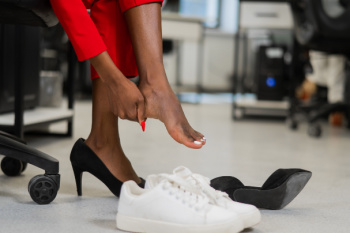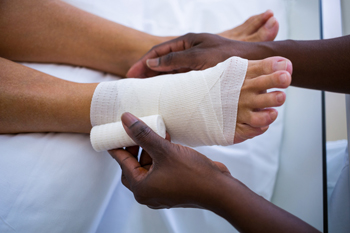Connect With Us
Blog
Items filtered by date: May 2025
Understanding Metatarsal Joint Pain

The metatarsals are the five long bones in the middle of the foot that connect the toes to the rest of the foot structure. These bones play a key role in weight bearing and movement, especially during walking, running, or standing for long periods. Metatarsal joint pain can occur when there is inflammation or strain in the area where these bones meet the toes. This pain is often described as a burning, aching, or sharp sensation in the ball of the foot and may worsen with activity. Causes can include overuse, wearing improper footwear, foot deformities, or arthritis. Rest, footwear changes, and padding can provide relief. Custom orthotics are sometimes recommended to improve alignment and reduce pressure on the joints. If pain in the ball of your foot is making it hard to stay active, it is suggested that you consult a podiatrist for an accurate diagnosis and effective treatment.
Arthritis can be a difficult condition to live with. If you are seeking treatment, contact Larry Slomowitz, DPM from California. Our doctor can provide the care you need to keep you pain-free and on your feet.
Arthritic Foot Care
Arthritis is a joint disorder that involves the inflammation of different joints in your body, such as those in your feet. Arthritis is often caused by a degenerative joint disease and causes mild to severe pain in all affected areas. In addition to this, swelling and stiffness in the affected joints can also be a common symptom of arthritis.
In many cases, wearing ill-fitting shoes can worsen the effects and pain of arthritis. Wearing shoes that have a lower heel and extra room can help your feet feel more comfortable. In cases of rheumatoid arthritis, the arch in your foot may become problematic. Buying shoes with proper arch support that contour to your feet can help immensely.
Alleviating Arthritic Pain
- Exercises that stretch the foot can prevent further pain and injury and increase mobility
- Most of the pain can be alleviated with anti-inflammatory drugs, heat, and topical medications
- Massages can help temporarily alleviate pain.
It is best to see your doctor for the treatment that is right for your needs and symptoms. Conditions vary, and a podiatrist can help you determine the right method of care for your feet.
If you have any questions please feel free to contact our office located in Westlake Village, CA . We offer the newest diagnostic tools and technology to treat your foot and ankle needs.
Do You Suffer From Painful Feet?
Preventing Foot and Ankle Pain While Running

Foot or ankle pain while running can stem from several causes, including overuse, improper footwear, poor running form, or underlying structural issues. Repetitive impact places stress on the joints, muscles, and tendons, leading to inflammation or irritation. Common conditions include plantar fasciitis, Achilles tendinitis, or stress fractures. Ankle pain may result from instability or tight calf muscles, which place extra strain on the joint. Wearing supportive shoes, warming up properly, and gradually increasing training intensity can help prevent discomfort. Runners benefit from cross-training to strengthen supporting muscles and improve flexibility. Paying attention to pain and allowing time for recovery also plays a key role. When managed proactively, foot and ankle pain does not have to interfere with enjoying or excelling in running. If you have developed this type of pain from running, it is suggested that you consult a podiatrist who can offer effective treatment remedies, and guide you on additional running injury prevention tips.
All runners should take extra precaution when trying to avoid injury. If you have any concerns about your feet, contact Larry Slomowitz, DPM of California. Our doctor will treat your foot and ankle needs.
How to Prevent Running Injuries
There are a lot of mistakes a runner can make prior to a workout that can induce injury. A lot of athletes tend to overstretch before running, instead of saving those workouts for a post-run routine. Deep lunges and hand-to-toe hamstring pulls should be performed after a workout instead of during a warmup. Another common mistake is jumping into an intense routine before your body is physically prepared for it. You should try to ease your way into long-distance running instead of forcing yourself to rush into it.
More Tips for Preventing Injury
- Incorporate Strength Training into Workouts - This will help improve the body’s overall athleticism
- Improve and Maintain Your Flexibility – Stretching everyday will help improve overall performance
- “Warm Up” Before Running and “Cool Down” Afterward – A warm up of 5-10 minutes helps get rid of lactic acid in the muscles and prevents delayed muscle soreness
- Cross-Training is Crucial
- Wear Proper Running Shoes
- Have a Formal Gait Analysis – Poor biomechanics can easily cause injury
If you have any questions, please feel free to contact our office located in Westlake Village, CA . We offer the newest diagnostic and treatment technologies for all your foot care needs.
Understanding Chronic Plantar Fasciitis

Chronic plantar fasciitis is a common cause of heel pain, especially in active individuals. It occurs when the plantar fascia, the thick band of tissue that runs along the bottom of the foot, becomes inflamed due to repetitive stress or strain. Common causes include overuse, wearing improper footwear, high-impact activities, or an abnormal gait. Symptoms typically include sharp or stabbing pain in the heel, particularly with the first steps in the morning or after prolonged rest. The pain may subside during the day but can return after standing or walking for long periods. A podiatrist can diagnose chronic plantar fasciitis through physical exams and imaging tests. Treatment options include custom orthotics to support the arch, targeted exercises to stretch and strengthen the foot, and anti-inflammatory medication. In more severe cases, injections or even surgery may be necessary. If you are dealing with painful plantar fasciitis, it is suggested that you promptly schedule an appointment to see a podiatrist.
Plantar fasciitis is a common foot condition that is often caused by a strain injury. If you are experiencing heel pain or symptoms of plantar fasciitis, contact Larry Slomowitz, DPM from California. Our doctor can provide the care you need to keep you pain-free and on your feet.
What Is Plantar Fasciitis?
Plantar fasciitis is one of the most common causes of heel pain. The plantar fascia is a ligament that connects your heel to the front of your foot. When this ligament becomes inflamed, plantar fasciitis is the result. If you have plantar fasciitis you will have a stabbing pain that usually occurs with your first steps in the morning. As the day progresses and you walk around more, this pain will start to disappear, but it will return after long periods of standing or sitting.
What Causes Plantar Fasciitis?
- Excessive running
- Having high arches in your feet
- Other foot issues such as flat feet
- Pregnancy (due to the sudden weight gain)
- Being on your feet very often
There are some risk factors that may make you more likely to develop plantar fasciitis compared to others. The condition most commonly affects adults between the ages of 40 and 60. It also tends to affect people who are obese because the extra pounds result in extra stress being placed on the plantar fascia.
Prevention
- Take good care of your feet – Wear shoes that have good arch support and heel cushioning.
- Maintain a healthy weight
- If you are a runner, alternate running with other sports that won’t cause heel pain
There are a variety of treatment options available for plantar fasciitis along with the pain that accompanies it. Additionally, physical therapy is a very important component in the treatment process. It is important that you meet with your podiatrist to determine which treatment option is best for you.
If you have any questions, please feel free to contact our office located in Westlake Village, CA . We offer the newest diagnostic and treatment technologies for all your foot care needs.
Options for Treating Gangrene

Treatment for gangrene that affects the feet, toes, or ankles focuses on removing dead tissue, fighting infection, and restoring blood flow. A podiatrist may begin by performing debridement. This is a surgical procedure that removes the damaged tissue and helps promote healing. When an infection is involved, antibiotics may be administered through a vein to ensure they reach the affected tissue. If gangrene results from reduced blood supply, surgery may be performed to restore circulation. One method of treating gangrene is bypass surgery, designed to redirect blood flow around a blockage. Another is angioplasty, which uses a small balloon to open a narrowed artery and may include placing a stent. In severe cases, where the affected tissue cannot be saved, loss of a toe or part of the foot may be necessary to prevent the gangrene from spreading. In gangrene linked to diabetic ulcers, hyperbaric oxygen therapy may also be used to increase oxygen levels in the blood and support healing. If you have developed gangrene from a diabetic foot ulcer, it is suggested that you schedule an immediate appointment with a podiatrist for the appropriate wound care.
Wound care is an important part in dealing with diabetes. If you have diabetes and a foot wound or would like more information about wound care for diabetics, consult with Larry Slomowitz, DPM from California. Our doctor will assess your condition and provide you with quality foot and ankle treatment.
What Is Wound Care?
Wound care is the practice of taking proper care of a wound. This can range from the smallest to the largest of wounds. While everyone can benefit from proper wound care, it is much more important for diabetics. Diabetics often suffer from poor blood circulation which causes wounds to heal much slower than they would in a non-diabetic.
What Is the Importance of Wound Care?
While it may not seem apparent with small ulcers on the foot, for diabetics, any size ulcer can become infected. Diabetics often also suffer from neuropathy, or nerve loss. This means they might not even feel when they have an ulcer on their foot. If the wound becomes severely infected, amputation may be necessary. Therefore, it is of the upmost importance to properly care for any and all foot wounds.
How to Care for Wounds
The best way to care for foot wounds is to prevent them. For diabetics, this means daily inspections of the feet for any signs of abnormalities or ulcers. It is also recommended to see a podiatrist several times a year for a foot inspection. If you do have an ulcer, run the wound under water to clear dirt from the wound; then apply antibiotic ointment to the wound and cover with a bandage. Bandages should be changed daily and keeping pressure off the wound is smart. It is advised to see a podiatrist, who can keep an eye on it.
If you have any questions please contact our office located in Westlake Village, CA . We offer the newest diagnostic and treatment technologies for all your foot and ankle needs.

